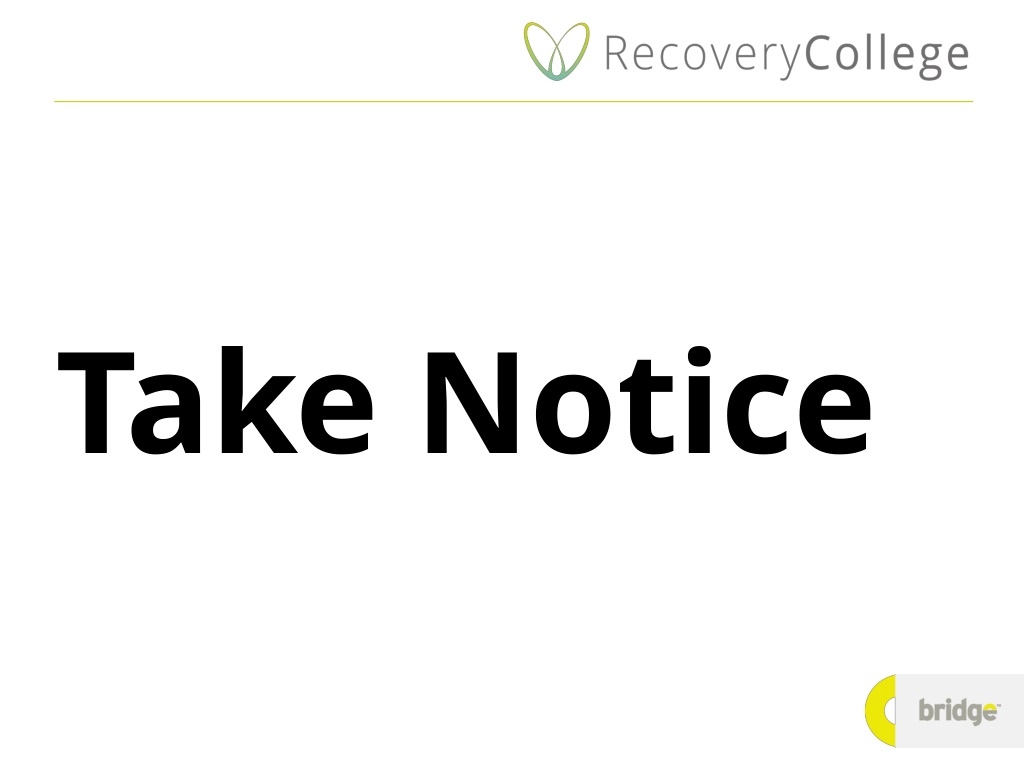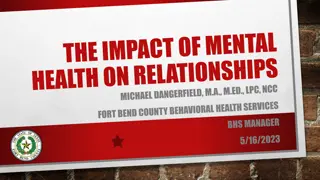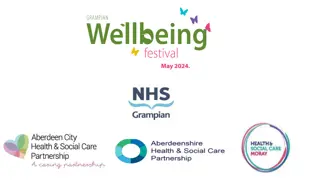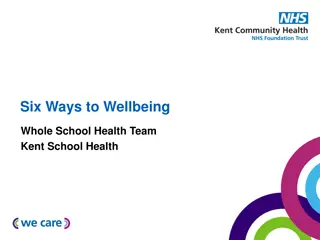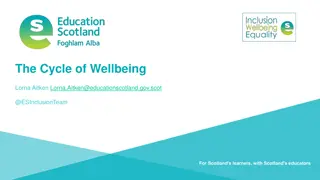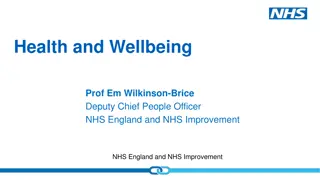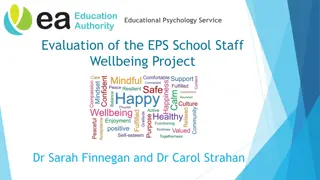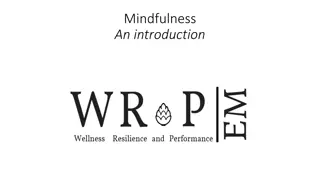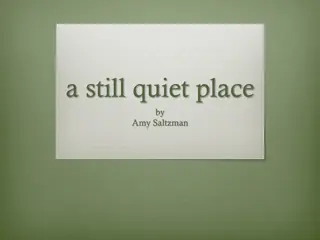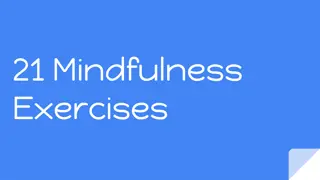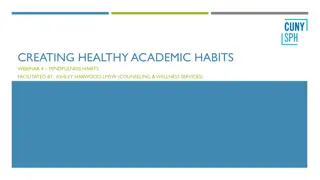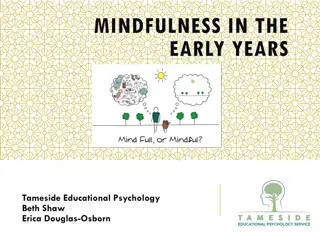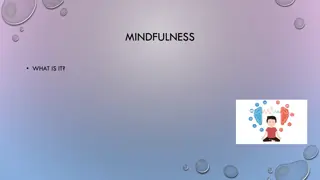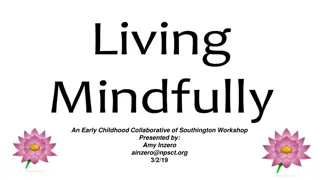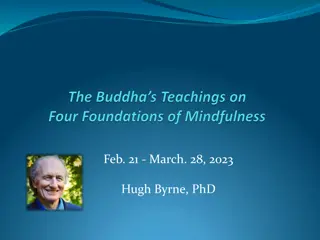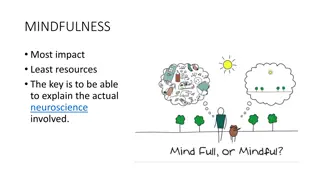Enhancing Mental Wellbeing Through Mindfulness
Paying attention to the present moment through mindfulness practices can significantly improve mental wellbeing. Taking notice of your thoughts and feelings, grounding techniques, and practicing self-awareness are essential steps towards enhancing mental health and reducing stress. By focusing on the present and exploring behaviors aligned with your values, you can free yourself from past worries and future anxieties, leading to a more balanced and fulfilling life.
Download Presentation

Please find below an Image/Link to download the presentation.
The content on the website is provided AS IS for your information and personal use only. It may not be sold, licensed, or shared on other websites without obtaining consent from the author.If you encounter any issues during the download, it is possible that the publisher has removed the file from their server.
You are allowed to download the files provided on this website for personal or commercial use, subject to the condition that they are used lawfully. All files are the property of their respective owners.
The content on the website is provided AS IS for your information and personal use only. It may not be sold, licensed, or shared on other websites without obtaining consent from the author.
E N D
Presentation Transcript
Take notice in a recovery context Paying more attention to the present moment to your own thoughts and feelings, and to the world around you can improve your mental wellbeing. Taking Notice is a step towards strengthening and widening your self-awareness. By developing a better connection to yourself (intrapersonal), where you are more aware of your our needs, values and interests, you can begin exploring and choosing behaviours that are consistent with these things. Focusing too much on past events and worrying about the future can have a negative impact on our mental health and wellbeing (Wang, 2016). Being present or practicing mindfulness can free you from the past and future, especially if you realise that, for several minutes, you have been trapped in reliving past problems or pre-living future worries.
Mindfulness means knowing directly what is going on inside and outside ourselves, moment by moment.. Mark Williams
How mindful are you? We spend so much time inside our heads, thinking about what we've done, or have yet to do, worrying about things. It s easy to stop noticing the world around us. It s also easy to lose touch with the way our bodies are feeling and to end up living in our heads caught up in our thoughts without stopping to notice how those thoughts are driving our emotions and behaviour. Ask yourself: Do you find it difficult to stay focused on what s happening in the present? Do you tend to walk quickly to get to where you re going without paying attention? Does it seem as if you are running on automatic without much awareness of what you are doing?
Grounding & Mindfulness Grounding techniques help you to stay in the moment and regain a sense of safety and control. Mental grounding Describe your environment in detail, using all your senses. Physical grounding Touch various objects around you: Notice textures, colours, materials, weight, temperature. Play a categories game. Dig your heels into the ground, Say a safety or coping statement. Carry a grounding object in your pocket. Say kind statements. Remember the words to an inspiring song, quote or poem. Stretch. Clench and release your fists. Visualise a place that is calming and safe. Focus on your breathing, noticing each inhale and exhale.
Grounding Technique: 5-4-3-2-1 Grounding techniques often use the five senses - sound, touch, smell, taste, and sight - to immediately connect you with the here and now. 5 things I can see (the colour red, beginning with the letter b etc.) 4 things I can hear 3 things I can feel or touch 2 things I can smell 1 slow deep breath
If I sentence completion exercise If I bring 15% more attention to my life today If I am more accepting of my emotions today
Take Notice how? Slow down and stop. Savour the moment. Reflect on your experiences. Try to see things with new eyes . Adopt a curious approach to life. Look for beauty in everything. Try mindful photography Taste your food. Eat slow. Listen to a new piece of music. What instruments can you hear? Take a different route to places. Remember to look up!
We know the world only through the window of our mind. When our mind is noisy, the world is as well. And when our mind is peaceful, the world is, too. Knowing our minds is just as important as trying to change the world. Haemin Sunim
Thinking vs Observing Cognitive Defusion involves distancing, disconnecting or seeing thoughts and feelings for what they are (streams of words, passing sensations), not what they say they are (dangers or facts). To develop an awareness of thoughts and feelings: Use the mantra: STOP, STEP BACK, OBSERVE. Look at thoughts, rather than from thoughts. Notice thoughts, rather than being caught up in thoughts. See thoughts as what they are, not as what they seem to be. Don t believe everything you think! Silently name the unhelpful thought: Here is the thought that I might fail that exam. Or, Here is anxiety. Use metaphors to see things differently.
Metaphors to Facilitate Cognitive Defusion Thoughts are like: Clouds floating, or birds flying, across the sky. Waves arising from the sea, then falling back in. You can watch the waves from the shore, without being swept away. Leaves and sticks floating down a stream. You don t have to dive in. You can watch from a bridge. A passing parade. You can watch the floats pass by. You don t have to climb on board. Trains coming and going while you stand watching from the platform. A waterfall. You re standing behind it, not under it. Guests entering a hotel. You can be like the doorman: you greet the guests but you don t follow them to their rooms. Suitcases dropping onto a conveyor belt at the airport. You can watch them pass by, without having to pick them up. People passing by you in the street. You can nod your head at them, but you don t have to stop and have a conversation. Wild horses running across the plains. You can admire them but no need to chase them. Bubbles rising in a champagne bottle. They rise to the surface and then disappear. Fish swimming in a tank. Watch them come and go. Actors on a stage. You can watch the play; you don t need to get on stage and perform. Pop-ups on the internet. Junk e-mail. You can t stop it from coming in but you don t have to read it! Text messages on your mobile phone. Luggage passing by on a conveyor belt.
Leaves on a Stream Imagine a beautiful slow-moving stream. The water flows over rocks, around trees, descends downhill, and travels through a valley. Once in a while, a big leaf drops into the stream and floats away down the river. Imagine you are sitting beside that stream on a warm, sunny day, watching the leaves float by. Now become conscious of your thoughts. Each time a thought pops into your head, imagine that it is written on one of those leaves. If you think in words, put them on the leaf as words. If you think in images, put them on the leaf as an image. The goal is to stay beside the stream and allow the leaves on the stream to keep flowing by. Don t try to make the stream go faster or slower; don t try to change what shows up on the leaves in any way. If the leaves disappear, or if you mentally go somewhere else, or if you find that you are in the stream or on a leaf, just stop and notice what has happened. File that knowledge away and then once again return to the stream, watch a thought come into your mind, write it on a leaf, and let the leaf float away down stream.
